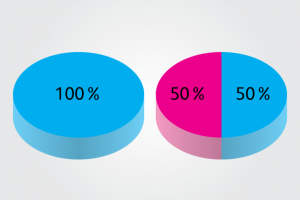A marketing management strategy aims to generate results that meet the business’s objectives.
Content Marketing is one strategy that helps bring these results. However, it is not just about creating good content, but also adopting some practices like understanding nofollow vs. dofollow links and knowing how to use them to your advantage.
If you want to see how to use those types of links in your SEO strategy, keep reading. Here, we will treat:
- What are the differences between nofollow vs. dofollow links?
- What should I take into account when doing a nofollow vs. dofollow link strategy?
Download this post by entering your email below
What are the differences between nofollow vs. dofollow links?
In order to understand the differences between nofollow vs. dofollow links, we must first clarify how link building works within SEO.
By that, we mean what happens every time a website or blog receives a new link that can increase its ranking in Google.
In the same way that each new content on your blog increases the chances of you being found by your audience, we can say that each new link increases your chances of having more visitors and better positioning in search engines.
After all, when Google’s algorithm identifies so many internal and external links pointing out to your website, it automatically understands that, if so many people are linking to this blog, then it must be a very good one.
Therefore, it should be in a better ranking position in search results.
What is dofollow link
Dofollow links are those that allow Google and other search engines to point back to your website or blog.
So, every time you insert a dofollow link on your site, it can point back to you, which strengthens your authority by showing search engines what other sites, blogs, and posts are linking to you.
For example: if Rock Content uses on its blog a link from company X that is dofollow, the page or blog post used in the link will be taken into account in the ranking.
This is called Link Juice by some users, and it occurs because of Google’s PageRank metric.
Therefore, when inserting external links on your blog, make sure they are from sites with good authority, as this will be very important for the growth of your blog’s authority.
What is nofollow link
On the other hand, there are those links that you can insert and not have it pointing back to you. They are called nofollow links. They do not boost PageRank, nor do they help with better placement on SERP.
Websites that have nofollow links have an HTML tag similar to <a href=”https://www.nameofthesite.com/” rel=”nofollow”> Link Text </a>.
This tag serves as a warning to search engines, so they do not consider it for the ranking of those who linked it on their website.
Tools like SEMRush can show you nofollow vs. dofollow links, so you can consider when inserting them into some of your content.
Why does anyone leave their own website or blog as nofollow?
Now that you understand the differences between nofollow vs. dofollow links, you may be wondering why some companies and professionals choose to have websites or blogs with nofollow links, which are beneficial for both linkers and linked parties.
Well, this is what happens: just as good links pointing to your domain make it better, bad links can decrease your authority with Google.
After all, just as the algorithm concludes something similar to “if many good sites are pointing to this guy, he must also be good”, it can also conclude “if so many bad sites are pointing to this guy, he must also be bad — and his SERP positioning needs to decrease”.
So, good websites certainly have nofollow links.
What should I take into account when doing a nofollow vs. dofollow link strategy?
Now see what points you should consider when inserting links on your website or blog that can be both dofollow and nofollow.
The first step is to find out which sites you want your content to mention and can also point you back as a dofollow.
Make sure they are relevant to your post and that they are not just there because of the link. Otherwise, search engines may consider your post as spam.
Do not underestimate the algorithm, because, with each update, Google considers more the content made for the user and not for the search engines.
If information is not that relevant, but you feel you need a link, choosing nofollow is better. Also, make sure that ad links, affiliates, and related ones are not dofollow.
To do this, use the nofollow tag every time you insert links you don’t want to be followed back. This is essential when it is necessary to quote links from competitors, not only in terms of niche but also of keywords.
What should I consider when inserting external links on my website or blog?
If you have a link to another website and want Google to recognize that you have linked to it, you must use a dofollow link.
This type of link is useful for search engines, as it can help bots get a better idea of what their content is about.
This is especially true because mentioning other sites is also a natural thing to do with good quality content.
At all times, Google favors texts that appear to be natural, rather than those that simply want to rank well, while negatively affecting user experience.
Remember those texts that repeated keywords to exhaustion and also filled content with links in an attempt to appear in search results? This used to work in the past, but it doesn’t work anymore.
What should I consider when having my links published on other sites and blogs?
Up to this point in the article, we discussed the differences between nofollow vs. dofollow links when inserting them on your website or blog. But what should we do when other websites or blogs are the ones doing the linking?
When that happens, some people think that we just have to accept being linked, because the more mentions we have on other websites, the better, right? Wrong.
While more links can have a direct impact on your domain’s search rankings, links coming from websites with little authority and credibility can hurt yours. Therefore, it is recommended that you do not follow them back.
But there’s nothing to worry about because even if links pointed on third-parties websites are nofollow, they will still be visible to people who visit the page — therefore, being a source of traffic to your own website.
An example of this consists of companies and professionals who insert their links on Wikipedia.
Although it is nofollow, the fact that the link is there can lead many readers to access it, increasing the number of visits, which is also one of Google’s ranking factors.
How do I get links to my website?
This is a recurring question among those who want to start doing SEO actions off-page.
After all, the bigger the number of trusted sites pointing to yours, the greater its relevance to search engines.
The first step is to truly create the best content on any topic. When you have truly relevant and useful content to your buyer persona, you have better odds of being well positioned in search results.
As a consequence, other websites will also start pointing to you as a reference for the subject that you discuss in your content.
In terms of active actions to make this happen, a good way is to create content for third-party blogs, what we call guest posts. Some blogs allow other people to write for them, which helps them have more content published. In return, you can insert links to your website in the article.
So try to write guest posts for sites that have good authority and some connection to your segment. If someone has a website about vegan food, it makes no sense to write content for a steakhouse, for example.
Now that you know the main differences between nofollow vs. do-follow links, how about getting deeper into understanding what link juice is? Just click on the link and enjoy!
Wrap Up
Are you looking to increase your website’s ranking on search engines like Google? Start by understanding the power of dofollow and nofollow links. Dofollow links help strengthen your authority and boost your website’s visibility, while nofollow links don’t directly impact your SEO ranking.
With WriterAccess, you can create high-quality content that attracts more visitors and increases your chances of earning valuable dofollow links. Our platform connects you with expert writers who can craft engaging articles for your blog or website. Plus, you’ll have access to a pool of talented professionals who can help you create a winning link-building strategy.
Sign up for a free trial of WriterAccess today and see the difference our platform can make in improving your SEO. Don’t miss out on the opportunity to enhance your website’s authority and drive more traffic!







